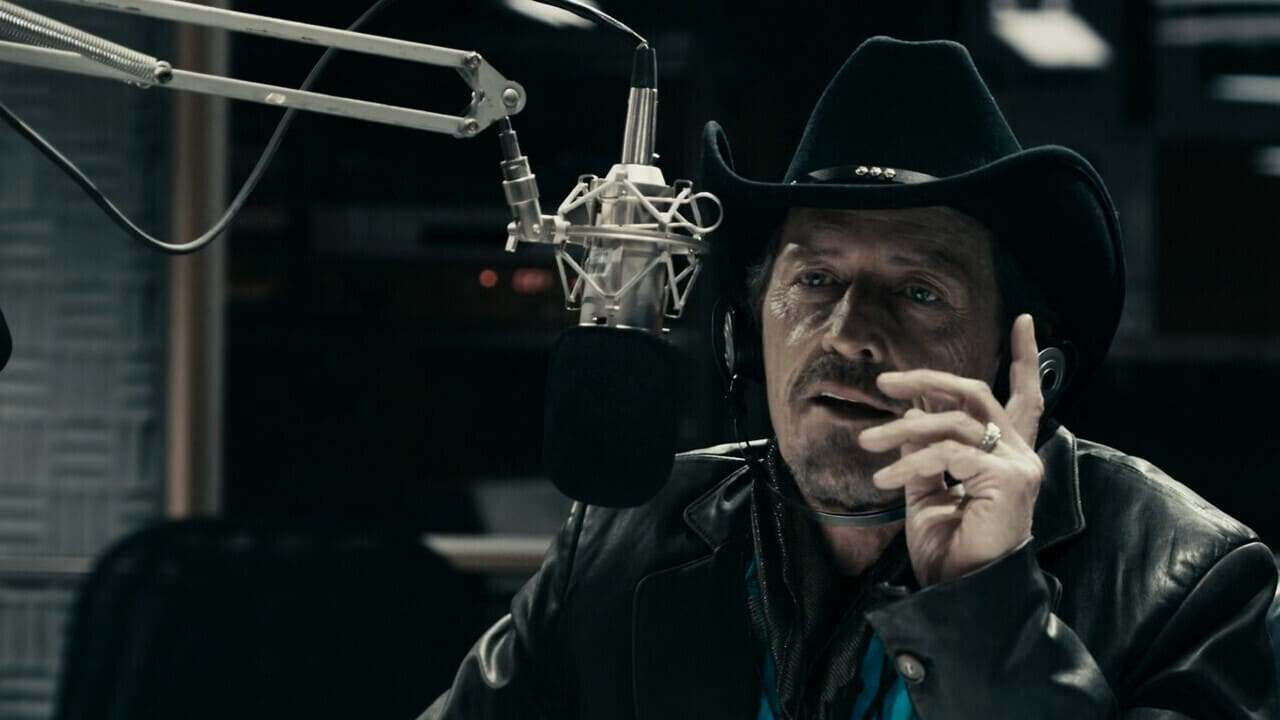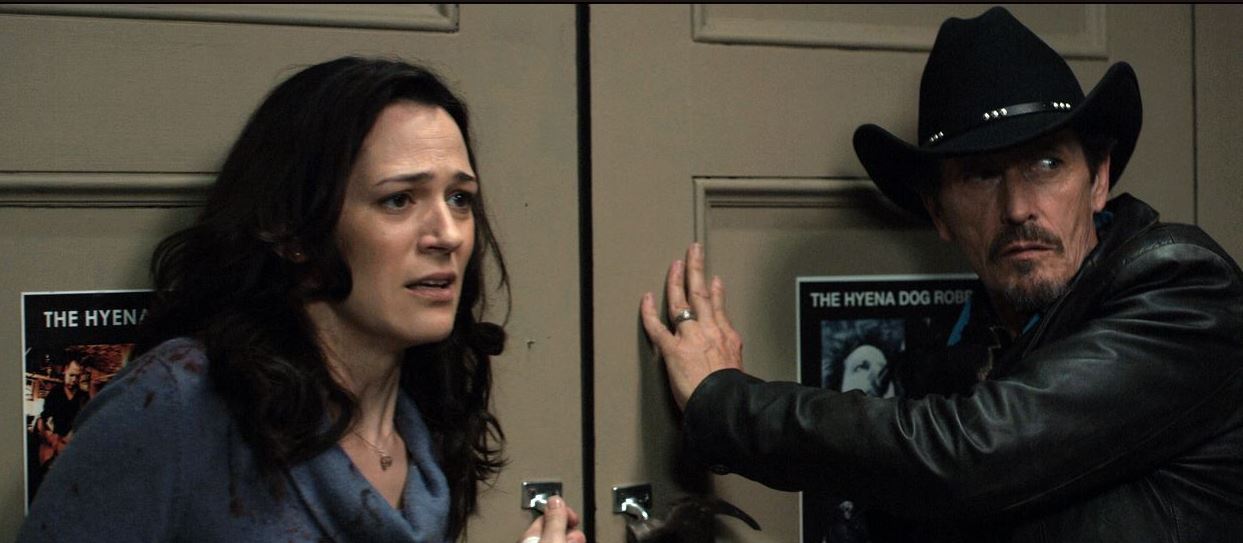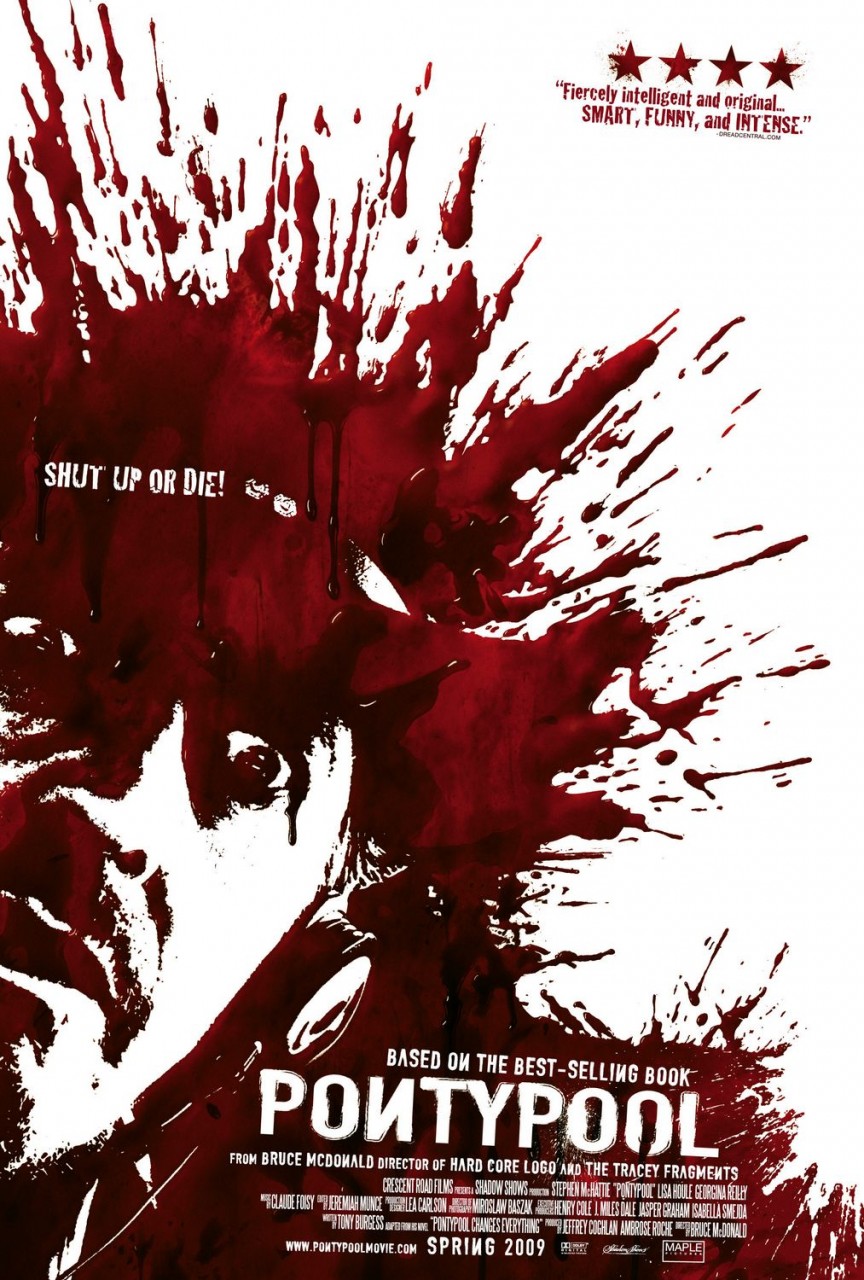Canada. 2008.
Crew
Director – Bruce McDonald, Screenplay – Tony Burgess, Based on His Novel Pontypool Changes Everything, Producers – Jeffrey Coghlan & Ambrose Roche, Photography – Miroslaw Baszak, Music – Claude Foisy, Visual Effects Supervisor – Aaron Weintraub, Visual Effects – Mr. X Inc, Special Effects Supervisor – Geoff Hill, Production Design – Lea Carlson. Production Company – Shadow Shows.
Cast
Stephen McHattie (Grant Mazzy), Lisa Houle (Sydney Briar), Georgina Reilly (Laurel-Ann Drummond), Hrant Alianak (Dr John Mendez), Rick Roberts (Voice of Ken Loney), Daniel Fathers (Voice of Nigel Healing)
Plot
Grant Mazzy takes up a new position as morning host on Radio 660 in the tiny town of Pontypool, Ontario. He immediately conflicts with his producer Sydney Briar who insists that his maverick, confrontational manner is not suited to a small town environment. While they are on air, they begin to cover a strange report where a mob of locals appear to attack a doctor’s office and then go crazy in the streets, during which several people are killed. As they monitor the crisis, the doctor himself seeks refuge in the studio. He explains that the townspeople are infected with a virus that hides inside certain words of the English language. The infectee initially stumbles over and then mindlessly repeats words, before becoming a zombie that needs to attack others to pass on the virus. As the infected emerge inside and surround the studio, Grant and the others struggle to get the message out, knowing that the very words they use could also transmit the virus to the outside world.
Bruce McDonald is a Canadian director with a modest reputation. McDonald gained attention with his second film Roadkill (1989) and then went onto the increasingly acclaimed likes of Highway 61 (1991), Hard Core Logo (1995), Hard Core Logo 2 (2010), which does feature some fantastic elements with a singer possessed by the spirit of the former film’s star, This Movie is Broken (2010), Trigger (2010), the Halloween horror Hellions (2015) and Dreamland (2019), a crime film that also features a vampire. These are films with a strong indie sensibility, albeit where Bruce McDonald has had to intersperse what he has wanted to do with more commercial work such as Tidal Wave (tv mini-series, 2007) and episodes of My Babysitter’s a Vampire (2011-2).
Pontypool was McDonald’s first venture into horror cinema. It joins the mountain of zombie films that came out during the 00s after the success of hits like 28 Days Later (2002), Dawn of the Dead (2004) and Shaun of the Dead (2004). Although, more than any of these, Pontypool falls into a body of films that have drawn themselves from George Romero’s The Crazies (1973) about a madness-inducing biospill. Others of these include the likes of Impulse (1984), Warning Sign (1985), The Signal (2007), Dead Air (2009), Nine Miles Down (2009), Salvage (2009), YellowBrickRoad (2010), Patient Zero (2012), Urge (2016), Mayhem (2017), Mom & Dad (2017) and The Sadness (2021) In fact, I would go so far as to say I found Pontypool a far superior film to the The Crazies (2010) remake that came out not long after. The nearest we have seen to the idea of Pontypool before is the Star Trek: Deep Space Nine episode Babel (1993), which concerned a bio-weapon that caused people to start babbling unintelligibly.
Pontypool hits in from its opening scene. Unusually, the credits play out against a sound oscillation wave with no other visuals, only the voice of Stephen McHattie on the soundtrack, talking about Pontypool and the origin of its name, which expands out into a random but entirely brilliant stream-of-consciousness monologue about the events. Everything in this scene becomes a reflection of what we are going to see in the film to come – the dialogue-only visuals reflects how the action throughout the film is constricted to the radio station and in effect plays out in its dialogue (Bruce McDonald states in interviews how the original intention had been to have the entire film take place via the dialogue and nothing else but this was abandoned); Stephen McHattie’s stream-of-consciousness monologue comes to reflect the film’s theme of the way language is fragmenting in the minds of the infected; Canada’s division between the English-speaking and French-speaking (Quebecois) part of the country is seen in the way it is explained how the town’s name came out of a mutated Franglais loanword, which is echoed in the latter half of the film with the amusingly subversive theme of the English-speaking Canadians being forced to abandon the English language and start speaking French.

Pontypool incidentally is a real town in Canada – it is not far from Lake Ontario and sits across the other side of the lake from New York. It is a proverbial one-horse town that I had never even heard of even though I live in Canada – no other West Coast Canadians I spoke to had heard of it either – a seasonal resort town with a population that never exceeds 2000. (The irony of the film is that it has placed Pontypool on the map even though none of the film was filmed in the town, everything instead being shot on sets in nearby Toronto).
The opening live-action scenes create a confrontational tension – Stephen McHattie’s arrival at the radio station and determination to play everything his way contrasted with producer Lisa Houle’s more cautious sensibilities. In these opening scenes, Bruce McDonald and Tony Burgess do a superb job of sketching out the principal characters of the film – Stephen McHattie as the leathery old-timer who is determined to be a maverick; Lisa Houle (Stephen McHattie’s real life wife) as the cautious, long-suffering producer; and Georgina Reilly as the shy but highly competent intern. All three characters are perfectly drawn, especially good being Stephen McHattie, an actor who is usually cast as a stony military types in films and uses the opportunity here to stretch his acting wings in a big way (on the basis of the film here, McHattie subsequently became regarded as a genre regular).
Above all, Tony Burgess writes Stephen McHattie’s dialogue for the sheer joy of it. You only need contrast Pontypool during these scenes to the one other zombie film featuring a radio host that we had the same year with the remake of Day of the Dead (2008), which featured an awful Ian McNeice inhabiting a similar role to Stephen McHattie, to see just how much Pontypool raises the bar of the zombie film.
These well-observed character interactions act as a superb introduction before the horror elements begin. Only two brief scenes occur outside the radio station – the majority of the drama is kept inside the studio, focused on the trio of characters reacting to things via telephone or tv screen as they try to keep the broadcast going. The contained nature of the drama does lead to a certain number of contrivations at various points – the introduction of a doctor for the sole purpose of having someone there to explain the virus; the character of Ken who relays what is happening via phone and is then cut off for long periods as other patches of drama are wheeled out before he manages to reconnect; or Georgina Reilly becoming infected and then being forgotten about for several minutes as a broadcast/interview takes place and reappearing again after.

Things begin with a banal inconsequentiality – Stephen McHattie being forced to grit his teeth as he interviews a musical act known as Lawrence and the Arabians (all Caucasians decked out in costume store burnooses) before the young girl breaks up and starts to babble, the description of the apparent riot downtown and their lack of information about what is happening even as they are being interviewed by overseas broadcasters who keep puzzlingly referring to a state of martial law being declared in the town.
As the drama begins, Bruce McDonald’s camera moves from wide and medium angles to closeups and quick cuts focused on the principals – the best means of creating dramatic tension in a statically enclosed environment. The scenes following the character of Ken as he describes by phone the horde of people moving through the town and then the abrupt cut to silence as a boy’s body is thrown through the window where he is hiding hold a considerable tension.
There are disturbing parts like where they translate the emergency broadcast messages in French that when deciphered contains alarming phrases such as “Do not translate … Please avoid the English language.” There is a chill as we watch Georgina Reilly being taken over and starting to babble her words before becoming a zombie mindlessly stumbling around the studio and trying to batter her head against the window of the recording booth.
The film becomes increasingly wilder with the introduction of Hrant Alianak’s doctor and all manner of speculations about how the virus is something that has inhabited the English language and is only present in certain words that infect the user when they understand them. Here Tony Burgess has cleverly drawn from the idea of meme theory that gained prominence during the 1990s through scientists like Richard Dawkins and Susan Blackmore (the idea that certain concepts are akin to biological units that pass from mind to mind). There are some ingeniously spooky scenes where the group sit wondering if the virus allows the infected Georgina Reilly to be able to lip read as well or whether they should continue broadcasting what is happening to the world, knowing that anything they say could possibly be broadcasting an infected word.
(Winner in Best Film this site’s Top 10 Films of 2008 list. Nominee for Best Adapted Screenplay and Best Actor (Stephen McHattie at this site’s Best of 2008 Awards).
Trailer here


